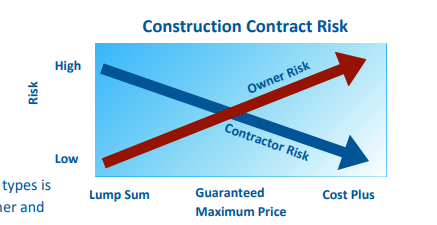All construction projects incur risks and require leaps of faith between both parties. One of the primary purposes of construction is to balance the risk associated with what can be a complicated risk-laden endeavor.
In the design-build process there are three types of contracts.
- Lump Sum(fixed price)
- Cost Plus
- Guaranteed Maximum Price(GMP)
The primary difference with each of these contract types is the allocation of the financial risk between the owner and the contractor.
Lump Sum Contracts
Lump sum contracts are sometimes referred to as fixed price contracts. They are generally used when the scope
and work is well defined. As the name implies, the owner and the contractor agree to a fixed price for an agreed
upon scope of work. The contractor is responsible for cost overruns.
Cost Plus Contracts
With a cost plus contract, the risk shifts from the contractor to the owner. This contract type is generally used when the
project is less defined and the owner and contractor are working to jointly develop the scope. The owner agrees to
reimburse the contractor for agreed upon expenses plus an additional payment to compensate the contractor as its fee
for managing the work. This fee can be fixed or based on a percentage of the work. However, the owner is responsible
for all costs, so these contracts are used when there is an established trust and confidence between the owner and
contractor.
Guaranteed Maximum Price Contracts
With a Guaranteed Maximum Price Contract, the owner and contractor also agree to a maximum price for the work.
Like a cost-plus contract, the owner agrees to reimburse the contractor for agreed upon expenses plus a fee. It is
generally used when the contractor is managing design to achieve a specific budget. A GMP contract also helps to
balance the financial risk between the owner and the contractor. Often, the difference between the actual cost of the
work and the GMP is shared between the owner and contractor, which helps to encourage a team approach to the
project.
Construction Contact Risk



